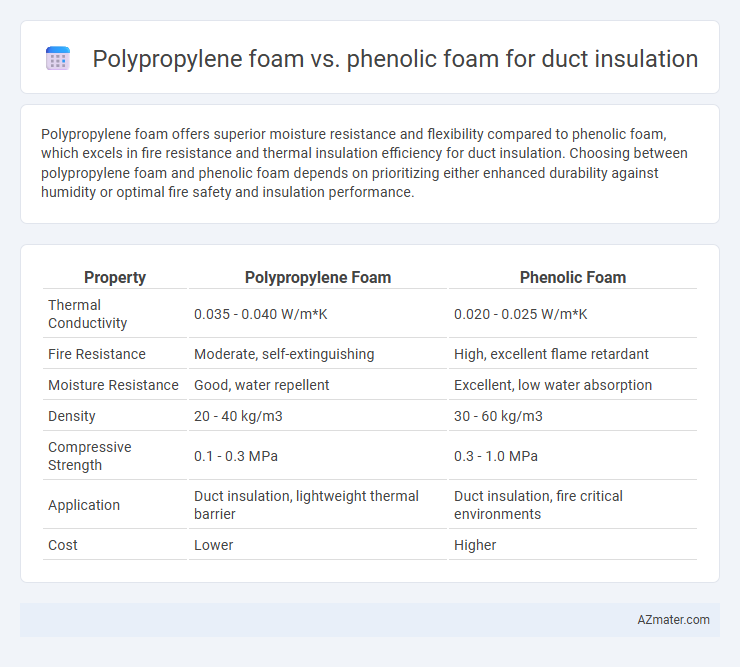Polypropylene foam offers superior moisture resistance and flexibility compared to phenolic foam, which excels in fire resistance and thermal insulation efficiency for duct insulation. Choosing between polypropylene foam and phenolic foam depends on prioritizing either enhanced durability against humidity or optimal fire safety and insulation performance.
Table of Comparison
| Property | Polypropylene Foam | Phenolic Foam |
|---|---|---|
| Thermal Conductivity | 0.035 - 0.040 W/m*K | 0.020 - 0.025 W/m*K |
| Fire Resistance | Moderate, self-extinguishing | High, excellent flame retardant |
| Moisture Resistance | Good, water repellent | Excellent, low water absorption |
| Density | 20 - 40 kg/m3 | 30 - 60 kg/m3 |
| Compressive Strength | 0.1 - 0.3 MPa | 0.3 - 1.0 MPa |
| Application | Duct insulation, lightweight thermal barrier | Duct insulation, fire critical environments |
| Cost | Lower | Higher |
Introduction to Duct Insulation Materials
Duct insulation materials such as polypropylene foam and phenolic foam are essential for improving energy efficiency and thermal performance in HVAC systems. Polypropylene foam offers excellent flexibility, moisture resistance, and cost-effectiveness, making it suitable for a variety of duct applications. Phenolic foam provides superior fire resistance, high thermal insulation values, and low smoke emission, ideal for environments with stringent safety regulations.
Overview of Polypropylene Foam
Polypropylene foam is a lightweight, closed-cell insulation material characterized by high thermal resistance and excellent moisture resistance, making it ideal for duct insulation in HVAC systems. Its flexibility and low density allow easy installation in tight spaces, while its chemical stability ensures durability and resistance to mildew and rot. Compared to phenolic foam, polypropylene foam offers superior impact resistance and lower water absorption, contributing to enhanced longevity and energy efficiency in duct insulation applications.
Overview of Phenolic Foam
Phenolic foam is a high-performance insulation material known for its excellent fire resistance, low smoke emission, and superior thermal conductivity, making it ideal for duct insulation in commercial and industrial applications. Its closed-cell structure provides outstanding moisture resistance and dimensional stability, enhancing durability and energy efficiency. Compared to polypropylene foam, phenolic foam offers better fire safety and insulating properties, though it typically comes at a higher cost and lower flexibility.
Thermal Performance Comparison
Polypropylene foam offers thermal conductivity values around 0.030-0.035 W/m*K, providing effective insulation with excellent moisture resistance, making it suitable for duct applications in humid environments. Phenolic foam typically exhibits lower thermal conductivity, approximately 0.020-0.025 W/m*K, delivering superior thermal insulation efficiency and better fire resistance than polypropylene foam. The enhanced thermal performance of phenolic foam results in lower heat transfer rates, contributing to improved energy savings and reduced HVAC system loads.
Fire Resistance and Safety
Polypropylene foam offers moderate fire resistance but can release toxic fumes when exposed to high heat, making it less ideal for duct insulation in fire-sensitive environments. Phenolic foam provides superior fire resistance with low smoke emission and self-extinguishing properties, enhancing safety by minimizing toxic gas release during combustion. Its thermal stability and flame-retardant characteristics make phenolic foam the preferred choice for fire-safe duct insulation applications.
Moisture and Chemical Resistance
Polypropylene foam demonstrates superior moisture resistance compared to phenolic foam, as it resists water absorption and prevents mold growth in duct insulation applications. Phenolic foam offers excellent chemical resistance, particularly against acids and alkalis, making it advantageous in environments with potential chemical exposure. The balance between polypropylene's hydrophobic properties and phenolic's chemical stability is critical for selecting optimal duct insulation based on specific moisture and chemical conditions.
Installation and Handling
Polypropylene foam offers lightweight and flexible characteristics that simplify cutting and fitting during duct insulation installation, making it easier to handle in tight spaces. Phenolic foam, while providing superior fire resistance and thermal insulation, tends to be more rigid and brittle, requiring careful handling to avoid cracking or breakage. The ease of installation with polypropylene foam often results in reduced labor time and fewer adhesive needs compared to the more delicate phenolic foam panels.
Environmental Impact and Sustainability
Polypropylene foam offers superior environmental benefits due to its recyclability and lower carbon footprint compared to phenolic foam, which often contains formaldehyde and uses non-renewable resources. Phenolic foam insulation generates more greenhouse gas emissions during production and disposal, posing greater environmental risks. Choosing polypropylene foam for duct insulation supports sustainability goals by reducing harmful emissions and promoting material reuse in building applications.
Cost Considerations
Polypropylene foam generally offers a lower initial cost compared to phenolic foam, making it an economically attractive option for duct insulation in large-scale projects. Phenolic foam, despite its higher upfront price, provides superior fire resistance and thermal performance, which can translate to long-term savings on energy and safety compliance costs. When evaluating cost considerations, it is essential to balance the initial material investment with potential lifecycle benefits such as durability, thermal efficiency, and regulatory requirements.
Conclusion: Choosing the Right Foam for Duct Insulation
Polypropylene foam offers excellent thermal insulation with superior moisture resistance, making it ideal for environments prone to humidity and condensation. Phenolic foam provides exceptional fire resistance and low smoke emissions, which are critical factors for enhancing duct safety in commercial and industrial settings. Choosing the right foam depends on prioritizing moisture control for polypropylene or fire safety compliance for phenolic in duct insulation applications.

Infographic: Polypropylene foam vs Phenolic foam for Duct insulation
 azmater.com
azmater.com